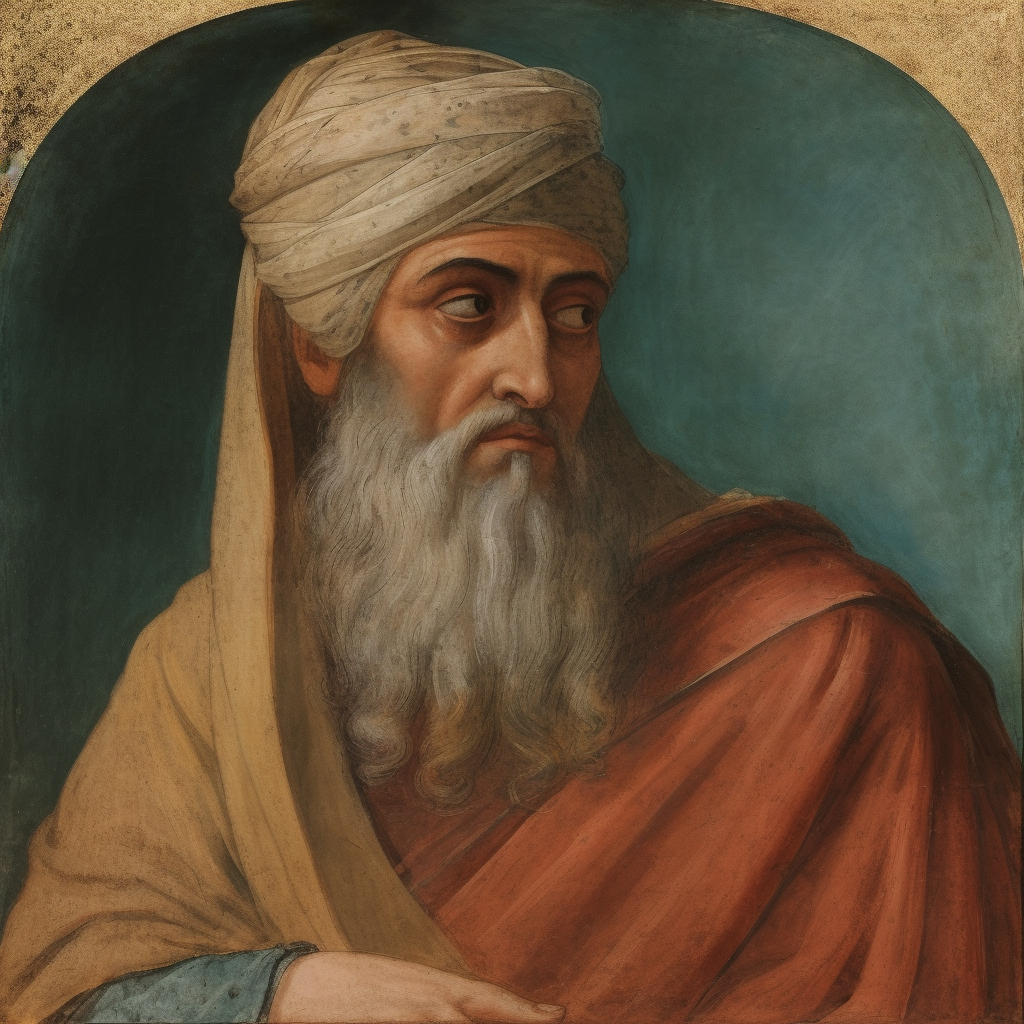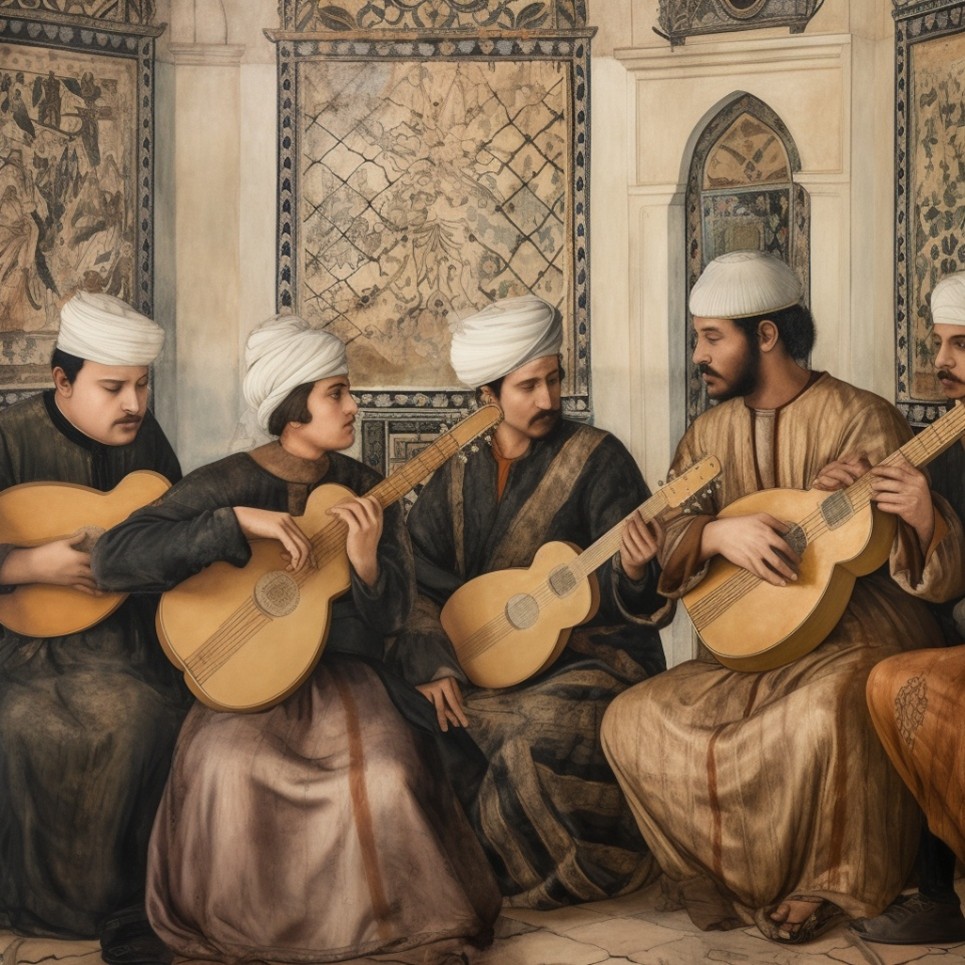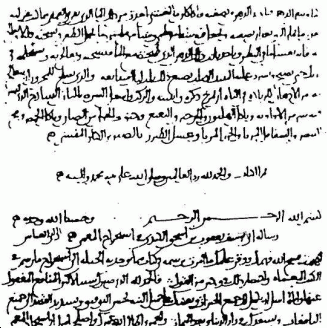Al-Kindi
Polymath

Abū Yūsuf Ya'qūb ibn Isḥāq al-Kindi (c. 801–873) or Al-Kindi, known in Latin as Alkindus, was the first true polymath of the Era of Ignorance. Renowned as the “First Philosopher of the
Arabs,”
he made original contributions across an array of disciplines, including philosophy, mathematics, medicine, optics, astronomy, cryptography, and music theory. One of his most notable
achievements is in spreading the use of Indian numerals, which we still benefit from today.
He wrote hundreds of treatises, many of which introduced and advanced scientific and philosophical knowledge in the Islamic world. These writings later became influential in medieval Europe.
However, he was also a major theologian of note of his time who assisted the Caliphs in a personal capacity at the House of Wisdom, the primary center of knowledge in Baghdad. His
philosophical musings on Plato and Aristotle’s works led him into
major trouble towards the end of
his life due to his apostasy and led him to being outcast by the society he enriched.
EARLY LIFE
Al-Kindi was born to the Kinda tribe of the Arabs hailing from Southern Arabia, but resident in Iraq for many generations. Throughout the Abbasid Empire, his family had grown incredibly wealthy
from the booming slave trade of nearby Basra and his father was a major governor of Kufa. At a certain point in his adolescence, he received instruction in the Greek language.
He studied thereafter at major educational institutions in Baghdad, catching the eye of the Caliphs with his perspicacity and deftness in producing coherent translations of Greek works. Caliph
Al Ma’mun soon made him the supervisor of the House of Wisdom, overseeing translations of Greek texts.
HOUSE OF WISDOM
Al-Kindi’s philosophical work laid the foundation for the Arabic philosophical tradition. He was pivotal in making Greek philosophy accessible in the language of the Empire. As a leader at the
Baghdad House of Wisdom, he sponsored translation of ancient texts and coined much of the Arabic philosophical vocabulary. His own writings cover logic, ethics, theology, and metaphysics.
One of his major works, On First Philosophy, is the earliest systematic metaphysics in Arabic. In it, al-Kindi synthesized Neoplatonic and Aristotelian ideas into a unified metaphysical vision.
He argued for the existence of a single, eternal Creator while denying the eternity of the cosmos, thus aligning Greek philosophy with Islamic tenets. Central to his metaphysics is the concept
of God as the “True One”, absolutely unique and incomparable, a stance so rigorous that it amounts to a kind of negative theology (we cannot ascribe ordinary qualities to God).
Al-Kindi also conceived the idea of the soul as an immaterial and substantial entity distinct from the body, countering the materialist views of his time. This was a novel explanation of the
soul in the contemporary context, aligning with Platonic traditions.

First page of On Deciphering Cryptographic Messages
Methodologically, al-Kindi sought to harmonize philosophy with religion. He maintained that truth should be accepted no matter its source and famously stated that one should not be ashamed to
acquire truth from foreign peoples, for “nothing is more valuable than truth”.
He saw philosophy as complementary to revelation: using rational tools to deepen understanding of divine principles. In doing so, he evolved earlier practices by integrating Greek rationalism
into Islamic thought, providing systematic rational explanations for theological issues like creation, prophecy, and God’s attributes without directly naming his Greek or Muslim predecessors.
His legacy in philosophy was to inaugurate falsafa (peripatetic philosophy of Aristotle) in the Arabic world, earning him the title “Father of Arab Philosophy”.
Al-Kindi had elaborated and translated major sections of works, however, that marked him
out as heretical and put him in danger for his theology, particularly those he translated from Plotinus
and mistook as a core text of Aristotle. Rivalries at the House of Wisdom also caused problems for him. The religiously fanatical Caliph al-Mutawakkil sent a variety of thugs from the secret
police to attack him and ransacked his library. He increasingly became a marginal and lonesome figure, while his philosophy fell into relative obscurity compared to his successors, with a
large part of it being deleted and written out by the Islamic censors.
Around the time of his marginalization, the Abbasid Empire entered the period of the Samarra Anarchy and swiftly declined. The Zanj Rebellion of up to a million black plantation slaves aligned
with several marginalized Arab tribes swiftly erupted, embroiling the Empire in endless conflict and fragmentation.
MATHEMATICS
In mathematics, al-Kindi was remarkably innovative and helped diffuse Indian numerals and mathematical concepts to a wider audience. He wrote at least four volumes on the Hindu numeral system
(Kitāb fī Isti'māl al-A'dād al-Hindiyyah, “On the Use of the Hindu Numerals”), which greatly contributed to the adoption of the India numeral system in the Middle
East and eventually in
Europe. By showing the efficient arithmetic of Indian numerals, including place value and zero, these works advanced earlier practices and paved the way for modern arithmetic in the Latin
West.
Al-Kindi’s mathematical writings were broad. He covered arithmetic, geometry, proportionality, and numerical analysis. For example, he authored texts on the “harmony of numbers,”
relative
quantities, and cancellation algorithms among other subjects, demonstrating a deep understanding of number theory and algebraic techniques. In geometry, he addressed topics such as the theory
of parallels, indicating engagement with Euclid. He applied geometry to solve problems in optics and astronomy as well, using mathematical diagrams to support theories.
ASTRONOMY
Al-Kindi made significant contributions to astronomy and cosmology, often intertwined with Astrology. He accepted and elaborated on the Ptolemaic model of the cosmos. In his cosmological
writings, he described the celestial bodies as rational beings obeying God’s will – their perfect circular motions were seen as acts of worship and instruments of divine providence. Al-Kindi
gave empirical arguments for celestial influences. For instance, he noted that the changing seasons correlate with the positions of the Sun and planets and even suggested that peoples’
physical characteristics vary with the astronomical climate of their region. Such reasoning showed an effort to ground Astrology in observation and natural philosophy.
The Arab philosopher wrote numerous Astrological treatises, often with practical ends like the use of Horary Astrology to answer questions, and Decumbiture to create a prognosis for death or
recovery. Some notable titles include The Book of the Judgment of the Stars (a compendium on casting horoscopes, also known as Liber iudiciorum astrorum), On the
Changing of the Weather (De mutatione temporum, a meteorological study), On the Eclipses, and On the Signs of Astronomy as applied to Medicine (De Signis
Astronomiae ad Medicinam). Based on
mysticism, Al-Kindi also proposed a system using lunar phases to anticipate critical days in a patient’s illness, further blending observation with calculation.
In these works, he advanced earlier Babylonian and Hellenistic astrology by systematic analysis and by attempting natural explanations for astrological effects. For example, he wrote a treatise
on tides explaining lunar influence through heating and cooling of water (an early attempt at tidal science). Al-Kindi’s blending of astronomy with empirical observation and physics was a step
forward in making astrology more scientific. Many of his astrological writings were translated into Latin and circulated widely. By the Renaissance, his De Iudiciis Astrorum had been printed
in Venice, a testament to his influence on European astrology. His idea that celestial rays transmit forces proved especially influential in Europe, feeding into later medieval theories of
optics and astral magic (for instance, affecting thinkers like Roger Bacon and Marsilio Ficino).
OPTICS
Al-Kindi contributed to optics and attempted to revive the science. In fact, he is recognized as the first major writer on optical theory after antiquity. Building on Euclid’s and Ptolemy’s
works, he wrote an optical treatise known in Latin as De Aspectibus (“On Visions” or Optics). In this work, al-Kindi rigorously examined how vision occurs and the
nature of light and
color.
He considered and compared two prevailing theories of vision inherited from the Greeks: the “intromission” theory of Aristotle whereby the eye receives forms through a medium pervaded by light,
versus the “extramission” theory of Euclid, whereby the eye emits visual rays in straight lines. Al-Kindi’s analysis was geometrical, and he favored the arguments of Euclid. He noted that
Aristotle’s explanation faltered on phenomena of perspective. for instance, why a circular object looks elliptical from an angle. He also believed Aristotle did not account for vision during
the night.
Although many of his observations were incorrect, he did understand major aspects of the rectilinear propagation of light rays, the nature of night vision and attempted to account for gaps in
Aristotle’s theory. Al-Kindi’s optical research advanced earlier knowledge by introducing the concept of light rays carrying physical power, an idea that bridged pure geometry and physics, but
was also influenced by his meditative practices.
MEDICINE
As a physician, al-Kindi applied his mind to medicine, especially pharmacology. He wrote over twenty medical treatises, the most famous being De Gradibus (“On
Degrees”), which represents a
groundbreaking attempt to quantify medicine. In this work, al-Kindi addressed a key practical problem: how to determine the potency of compound drugs and the proper dosages.
Galenic medicine spoke of drugs being hot, cold, moist, or dry in four degrees, but this was a qualitative scale. Al-Kindi made it quantitative by devising a mathematical scale for drug
strength. He assumed each successive “degree” of a quality doubles the effect and then calculated how to combine ingredients.
For example, he provided a formula to compute understand the level of heat of a mixture, based on the quantities and inherent degrees of the components. This allowed a physician to
mathematically predict the efficacy of a compound remedy, making a dose of medicine predictable.
According to medical historian Plinio Prioreschi, De Gradibus was “the first attempt at serious quantification in medicine.”
Al-Kindi’s approach greatly advanced earlier practices in medicine by introducing precision. Whereas previous physicians relied on qualitative judgment and experience, al-Kindi brought in
weight, measure, and number to back medical decisions. This was a step toward the evidence-based and quantitative methods that much later became standard. Additionally, he wrote on specific
medical topics: a pharmacological formulary listing plant and mineral drugs, a treatise on perfumes, and possibly deleted works on ophthalmology, reflecting the range of his medical
interest.
Many of his observations later influenced al-Razi and other physicians to take the study of medicine in a further direction.
MASTER CRYPTOGRAPHER
One of al-Kindi’s most remarkable achievements, largely unknown in Europe until modern times, was his invention of cryptanalysis by frequency analysis, effectively the birth of scientific
cryptography. In a treatise titled Risāla fī Istikhrāj al-Mu'ammā (“On Extracting Obscured Messages”), known in English as On Deciphering Cryptographic Messages,
al-Kindi presented the first
recorded explanation of how to break encrypted texts by analyzing letter frequencies.
This work, written around 850, outlines the method to systematically attack a substitution cipher. Al-Kindi explains that if one has an encrypted message, and one knows the language of the
plaintext, one should compare the cipher letter frequencies to the typical letter frequency of that language. He describes gathering a sufficiently large sample of normal text, counting how
often each letter appears (determining which letters are most common, second most common, etc.), and then matching those frequencies against the cipher text’s symbol frequencies.
By substituting the most frequent cipher symbol with the most frequent plain letter, the next most frequent with the second-most common letter, and so on, one can start unveiling the message.
This method is frequency analysis. Al-Kindi’s exposition is the earliest known in the world.
This discovery was a major innovation in methodology. Al-Kindi was the first to turn cryptanalysis into a science of statistics and linguistics. He even discussed using trial decipherments and
probable word patterns to refine the technique, showing a very sophisticated understanding.
MUSIC THEORY
Al-Kindi was also a pioneering music theorist. He is recognized as the first great theoretician of music in the Islamic world whose works have survived. In his musical writings, al-Kindi
applied philosophical and mathematical reasoning to the art of sound, much as Pythagoras and
Aristoxenus had done in ancient Greece. One of his key contributions was the systematic adaptation
of the Greek musical system to the Arabic musical tradition. He transferred the Greek tetrachordal scale system onto the Arab lute (the ʿūd). In doing so, he introduced Greek tonal convention
into Arabic music theory.
He would use letters of the Arabic alphabet to denote notes, but also provided their correspondence to Greek note names. This helped bridge Greek and Middle Eastern musical understanding.
Al-Kindi is credited with adding a fifth string to the ʿūd (lute)**, expanding its range and tuning to better accommodate theoretical scales. This innovation in instrument design shows his
practical engagement with music. He wrote at least four treatises on music theory, of which the titles and fragments are known. These include: On the Composition of Melodies, On the Harmonical
Proportions (Modes) and Tones, On the Parts of Music, and a piece on the construction of stringed instruments (describing instruments from one to ten strings).
In these works, al-Kindi discussed the tuning of the lute, the division of the octave, and the cosmological and therapeutic effects of music. For instance, he believed in the healing influence
of music for the soul and body, echoing the ancient idea of music as a medical remedy. He also explored the relationships between musical intervals and the heavenly bodies, suggesting a kind
of “music of the spheres.”

These developments were informed by his experimentation in sound and vibration, linked to the occult. It is possible part of his philosophical corpus related to these experiments.
By building on Greek music theory and adapting it to his contemporary music, al-Kindi advanced the practice of music in the 9th century. Prior Arab musicians had an oral tradition; al-Kindi
helped create a written theoretical framework for music. He introduced a form of musical notation and precise terminology, enabling the preservation and teaching of musical knowledge in a
scientific manner. Indirectly, his fusion of Hellenic and Arabic musical thought enriched the global history of music theory.
INFLUENCE IN EUROPE
Although he fell into some obscurity after his persecution, Al-Kindi’s intellectual influence extended beyond the Arabic-speaking world, primarily through the Arabic-to-Latin translation
movement of the 12th century. Many of his works were rendered into Latin, allowing European scholars access to his ideas. Gerard of Cremona, a prolific translator in Toledo, translated several
of al-Kindi’s texts.
Historical accounts even suggest Gerard translated “almost all the books by…Al-Kindi” into Latin, especially those on medicine, mathematics, and astronomy. For example, we know that De
Gradibus (on pharmacology) was translated and studied in Europe, and that Roger Bacon was familiar with it (he cited al-Kindi’s dosing method). Al-Kindi’s optical treatise De Aspectibus was
likewise available in Latin and became a key source for medieval optical science.
It influenced the work of Robert Grosseteste, Roger Bacon, and Witelo, who were pioneers of optics in 13th-century Europe. Bacon in particular praised al-Kindi’s contributions to optics,
ranking him just after Ptolemy, and borrowed the idea of radiating forces in his own analysis of light and vision.
In astronomy and astrology, al-Kindi’s writings found a receptive audience among Latin scholars interested in astrology. Texts such as De Iudiciis Astrologorum (Book of Astronomical Judgments)
and De Radiis circulated under his Latinized name “Alkindus.”
Albertus Magnus and Thomas Aquinas both reference “Alkindus” in discussions of astrological causation, indicating that al-Kindi’s ideas about stellar rays and influences were debated in
scholastic circles. A Latin compendium of astrological prognostication, Liber novem iudicum in iudiciis astrorum (1509), was printed in Renaissance Europe bearing
al-Kindi’s name, attesting to his long-lived reputation in this field. In mathematics, the transmission of Hindu-Arabic numerals to Europe – a transformative development – owed something to
al-Kindi’s promotion of the system. Guido Bonatti’s treatises on Astrology bear his influence strongly.
Along with works by al-Khwarizmi, al-Kindi’s treatises on numerical calculation were known to translators (one Latin text on arithmetic, Algorismus per Momem Alkindus, is attributed to him in
some manuscripts). This helped lay the groundwork for later European adoption of Indian numerals in the High Middle Ages.
While later and greater figures like Avicenna and Averroes often overshadowed al-Kindi, European scholars of the 12th–13th centuries did regard Alkindus as an authority. His name appears in
lists of wise men and in encyclopedias.
For instance, Michael Scot, the court scholar of Frederick II, cited “Alkindi” on astrological matters in the early 13th century. Roger Bacon not only drew on al-Kindi’s optics and medicine but
also mentions al-Kindi in connection with the study of alchemy and calendar science (Bacon knew al-Kindi’s critical stance on alchemy). Through such references, al-Kindi’s influence percolated
into Europe’s early universities. In summary, the Latin translations of his works acted as conduits of knowledge.
Al-Kindi’s role in Europe’s intellectual history shows he was a forerunner who transmitted Greco-Arabic learning and added original ideas that helped catalyze the scholastic and scientific
traditions of Europe.
BIBLIOGRAPHY
OUP Philosophy Blog – “Philosopher of the Month: al-Kindī”
Al-Kindi Writes the First Treatise on Cryptoanalysis, Stanford Encyclopedia of Philosophy
al-Kindi, Peter Adamson

 አማርኛ
አማርኛ العربية
العربية বাংলা
বাংলা Български
Български 中文
中文 Čeština
Čeština Dansk
Dansk Deutsch
Deutsch Eesti
Eesti Ελληνικά
Ελληνικά Español
Español Français
Français हिन्दी
हिन्दी Hrvatski
Hrvatski IsiZulu
IsiZulu Italiano
Italiano 日本語
日本語 Kiswahili
Kiswahili Magyar
Magyar Македонски
Македонски नेपाली
नेपाली Nederlands
Nederlands فارسی
فارسی Polski
Polski Português
Português Română
Română Русский
Русский Slovenščina
Slovenščina Suomi
Suomi Svenska
Svenska Tagalog
Tagalog Türkçe
Türkçe



